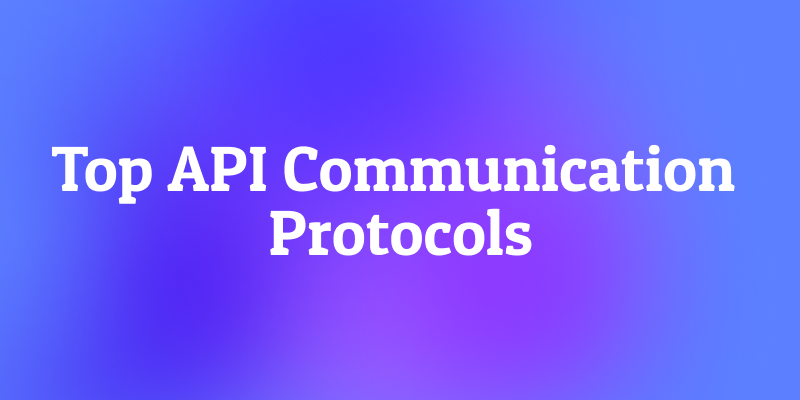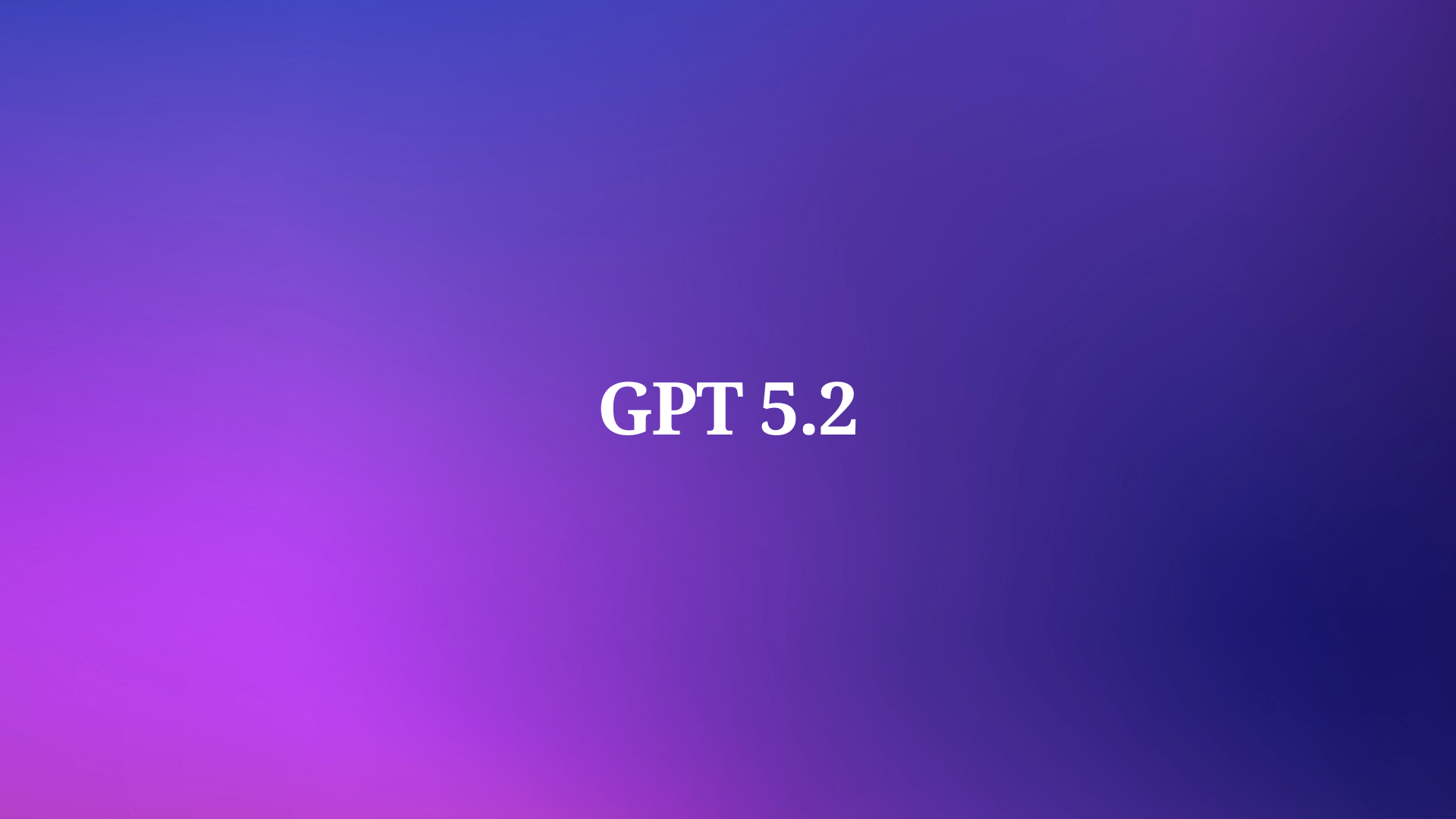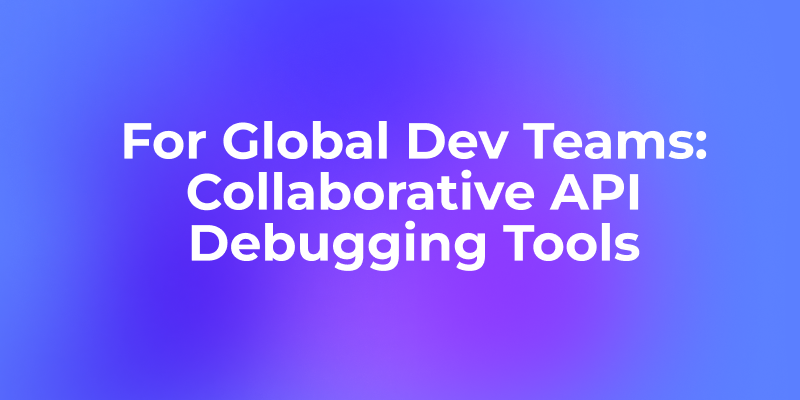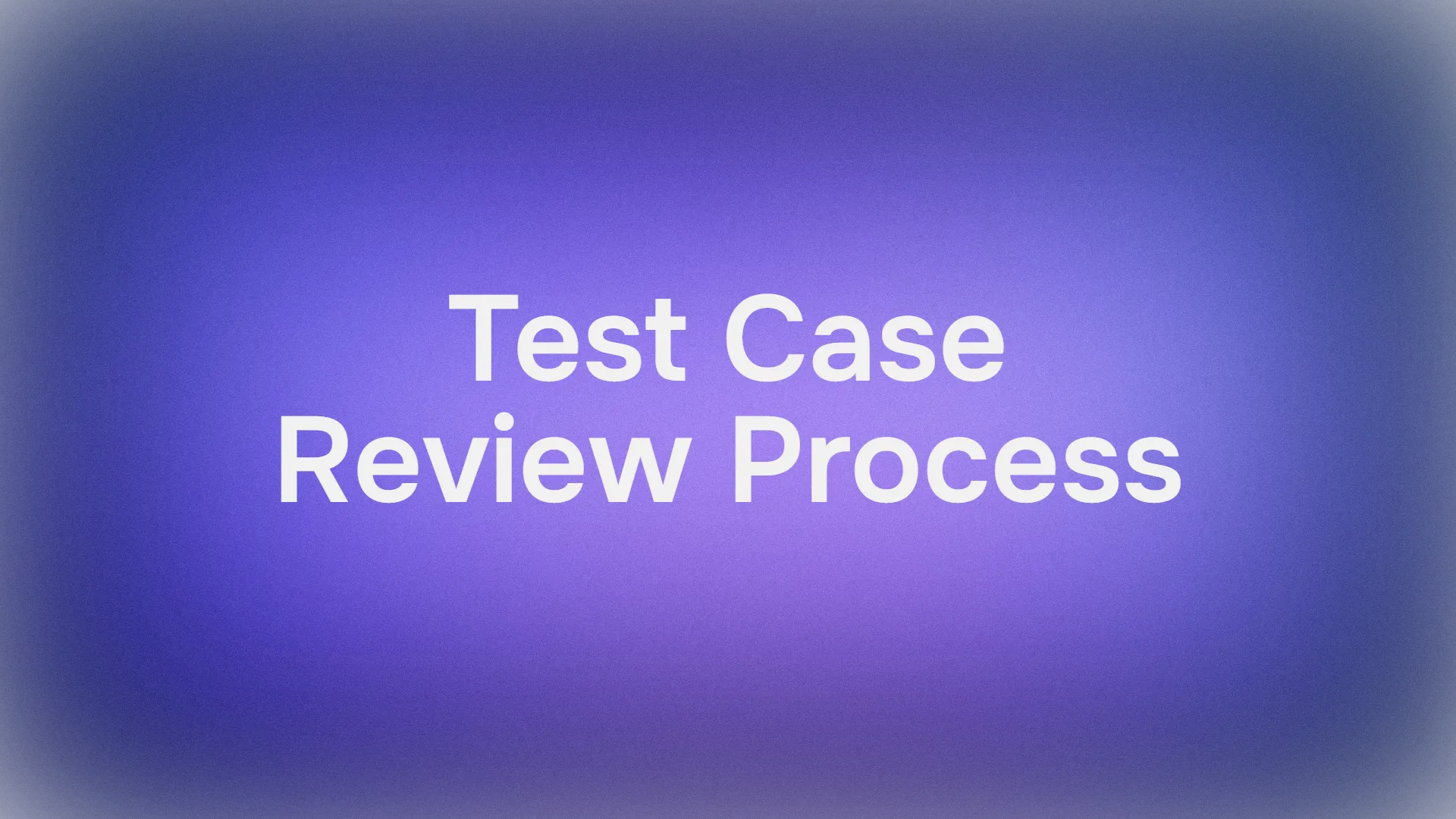So, you've decided to build an API. Fantastic! You're about to unlock a world of integration and scalability. Your first thought is probably: "I'll just build a REST API." It's the default, the king, the comfortable choice.
But what if REST isn't the best choice for your specific project? What if there's a protocol out there that's faster, more efficient, or better suited to real-time data?
The truth is, the world of API communication is vast and diverse. Choosing the right protocol isn't just a technical detail, but it's a foundational decision that will impact your application's performance, scalability, and developer experience for years to come.
In today's fast-paced digital world, APIs are the bridges that connect different software systems, enabling them to communicate and share data seamlessly. But have you ever wondered how these APIs actually talk to each other? What makes the communication between servers, apps, and devices so efficient and reliable? If you've ever wondered "What's the best way for APIs to communicate?" or "Which method should I use for my project?" you're in the right place.
In this post, we'll explore the top 10 API communication protocols, the languages and standards APIs use to chat back and forth. From traditional HTTP-based REST calls to cutting-edge real-time streaming technologies, each protocol has its strengths and ideal use cases.
And before we dive into our top 10 list, if you're evaluating or working with any of these technologies, you need a tool that can handle their complexity. Download Apidog for free; it's an all-in-one API platform that supports designing, testing, and mocking everything from RESTful endpoints to WebSocket connections, helping you make the right choice before you commit.
Now, let's explore the diverse and powerful landscape of how applications talk to each other.
Why API Communication Protocols Matter
Before jumping into the list, it's important to understand why API communication protocols are crucial. Imagine two people trying to have a conversation but speaking different languages. Without a common language or translator, meaningful discussion would be impossible. APIs aren't just about sending and receiving data they're about how that communication happens.
Similarly, API protocols define rules for:
- How data is sent and received
- How connections are established and maintained
- Data formats and serialization
- Ensuring reliability, security, and low latency
Choosing the right protocol affects the performance, scalability, and capabilities of your applications.
For instance:
- Should data be requested only when needed?
- Should the server constantly push updates to the client?
- Should the communication be synchronous or asynchronous?
These choices matter because they affect performance, scalability, user experience, and even costs. Understanding different API communication methods is like having the right tools in your toolbox; you need to pick the right one for the job.
1. REST: The Reigning Champion
What it is: Representational State Transfer (REST) is an architectural style, not a strict protocol. It's the most common way to design APIs on the web today. RESTful APIs use standard HTTP methods (GET, POST, PUT, DELETE) to perform operations on resources, which are identified by URLs.
How it communicates: HTTP/1.1 with JSON (most commonly) or XML payloads.
GET /users/123-> Retrieves user with ID 123.POST /users-> Creates a new user (with data in the request body).PUT /users/123-> Updates user 123 (full replacement).DELETE /users/123-> Deletes user 123.
Pros:
- Simple & Familiar: Uses well-understood HTTP conventions.
- Stateless: Each request contains all necessary information, making it easy to scale.
- Cachable: HTTP caching mechanisms can dramatically improve performance.
- Loosely Coupled: Clients and servers evolve independently.
Cons:
- Over-fetching/Under-fetching: Clients often get too much data or need to make multiple requests for what they need.
- No Standard Schema: While OpenAPI helps, the structure of requests/responses is up to the designer, leading to inconsistency.
- Chatty: Complex UIs may require numerous round trips to the server.
Best for: Public APIs, CRUD-based applications, simple microservices, and situations where broad compatibility and ease of use are paramount. It's the perfect starting point for most projects.
2. GraphQL: The Precise Query Language
What it is: Developed by Facebook, GraphQL is a query language and runtime for your API. It allows clients to request exactly the data they need, nothing more and nothing less. Instead of multiple endpoints, you typically have a single endpoint that accepts queries.
How it communicates: HTTP POST requests where the body contains a GraphQL query document.
Pros:
- Efficient Data Retrieval: Solves over-fetching and under-fetching in one fell swoop.
- Single Round Trip: Complex data requirements can be satisfied in a single request.
- Strong Typing: The API is defined by a schema, providing excellent documentation and validation.
- Client-Driven: Frontend developers can specify their data needs without backend changes.
Cons:
- Complexity: Adds complexity on the server-side and requires thinking in graphs, not resources.
- Caching: HTTP caching is much harder than with REST. Complex caching strategies are required.
- N+1 Query Problem: Poorly designed resolvers can lead to inefficient database queries.
Best for: Complex applications with demanding UIs (e.g., dashboards, social feeds), mobile clients where bandwidth is precious, and situations where the frontend and backend teams need to work independently.
3. gRPC: The High-Performance Powerhouse
What it is: Developed by Google, gRPC (Google Remote Procedure Call) is a modern, high-performance RPC framework that can run anywhere. It is based on the idea of calling a remote function as easily as calling a local one. It uses HTTP/2 as its transport protocol and Protocol Buffers (Protobuf) as its interface definition language and message format.
How it communicates: HTTP/2 with binary Protobuf payloads. You define your service methods and message types in a .proto file, and code is generated for clients and servers.
Pros:
- Blazing Fast: Binary serialization with Protobuf is extremely efficient and small.
- HTTP/2 Benefits: Inherits multiplexing, header compression, and streaming from HTTP/2.
- Strongly Typed Contracts: The
.protofile is the unambiguous source of truth. - First-Class Streaming: Excellent support for bidirectional streaming communication.
Cons:
- Less Human-Readable: Binary formats aren't easy to debug like JSON (though tools like Apidog are making this easier).
- Browser Support: Requires a gRPC-web proxy for most web browsers, adding complexity.
- Steeper Learning Curve: Requires understanding of Protobuf and RPC concepts.
Best for: Internal microservices communication, real-time streaming services, polyglot environments where performance is critical (e.g., in financial services or gaming).
4. WebSocket: The Real-Time Dialogue
What it is: WebSocket is a communications protocol that provides full-duplex, persistent communication channels over a single TCP connection. Unlike HTTP, which is request-response, WebSocket allows the server to push data to the client whenever it's available.
How it communicates: After an initial HTTP "handshake," the connection is upgraded to a persistent WebSocket connection where both client and server can send messages (text or binary) at any time.
Pros:
- True Real-Time: Enables true real-time features like live chat, notifications, and live feeds with minimal latency.
- Efficient: Eliminates the overhead of repeated HTTP headers and connections for frequent messages.
- Full-Duplex: Simultaneous two-way communication.
Cons:
- Stateful: The persistent connection is stateful, which can make horizontal scaling more complex.
- Not Request-Response: Doesn't fit the typical CRUD model; it's for streaming events.
- Proxy & Load Balancer Configuration: Some infrastructure isn't optimized for long-lived WebSocket connections.
Best for: Real-time applications: chat apps, live sports updates, collaborative editing tools, real-time dashboards, and multiplayer games.
5. Webhook: The Event-Driven Callback
What it is: A Webhook is a way for an application to provide other applications with real-time information. It's sometimes called a "reverse API." Instead of you polling an API for data, you register a URL with a provider, and they send an HTTP POST request to that URL when an event occurs.
How it communicates: Standard HTTP POST requests with a JSON payload.
- Example: You register
https://myapp.com/payment-successwith Stripe. When a payment is successful, Stripe sends a POST request to that URL with the payment details.
Pros:
- Event-Driven & Efficient: Eliminates the need for wasteful polling. You only get data when there's something new.
- Real-Time Updates: Provides immediate notifications of events.
- Decoupled: The sender and receiver are completely decoupled.
Cons:
- Reliability: Your endpoint must be available to receive the webhook. Retry logic is crucial.
- Security: You must verify that incoming requests are truly from the expected sender (e.g., using HMAC signatures).
- Debugging: Can be difficult to debug because the trigger is controlled by an external system.
Best for: Event notifications: payment processing, CI/CD pipelines, third-party integrations (e.g., Slack notifications), and data synchronization.
6. SOAP: The Enterprise Veteran
What it is: SOAP (Simple Object Access Protocol) is a mature, XML-based protocol for exchanging structured information. It is highly standardized and comes with a wealth of enterprise-level features (WS-* standards) built-in, like security and transactions.
How it communicates: HTTP/HTTPS (typically) with rigidly structured XML envelopes.
Pros:
- Standardized & Extensible: A rich set of standards (WS-Security, WS-AtomicTransaction) makes it good for high-stakes environments.
- Language & Platform Agnostic.
- Built-in Error Handling.
Cons:
- Verbose & Heavy: XML is much more bloated than JSON.
- Complex: Can be difficult to implement and work with compared to REST.
- Less Readable: XML is harder for humans to read than JSON.
Best for: Large enterprises, financial institutions, and legacy systems where formal contracts and advanced security features are non-negotiable.
7. MQTT: The Protocol for the Internet of Things (IoT)
What it is: MQTT (Message Queuing Telemetry Transport) is a lightweight, publish-subscribe network protocol designed for constrained devices and low-bandwidth, high-latency networks. It's the standard for IoT.
How it communicates: A client publishes messages to a "topic" (e.g., sensor/123/temperature) on a broker (server). Other clients subscribe to that topic to receive the messages.
Pros:
- Extremely Lightweight: Small packet sizes conserve battery and bandwidth.
- Reliable: Designed to handle unreliable networks with quality of service (QoS) levels.
- Scalable: The broker can handle millions of connected devices.
Cons:
- Not a General-Purpose API: Designed specifically for messaging, not for CRUD operations.
- Requires a Broker: Adds an additional infrastructure component to manage.
Best for: IoT applications, mobile push notifications, real-time metrics from sensors, and any scenario with unreliable networks or constrained devices.
8. Apache Kafka: The Event Streaming Platform
What it is: While not an API protocol per se, Kafka is a distributed event streaming platform that is often the backbone of modern event-driven architecture. It's a publish-subscribe model that durably stores streams of events (records) in topics.
How it communicates: Clients use proprietary Kafka protocols (over TCP) to produce (write) and consume (read) streams of events. It's often used behind APIs.
Pros:
- Durability: Events are persisted and fault-tolerant.
- High Throughput: Designed to handle massive volumes of data in real-time.
- Decoupling: Producers and consumers are completely independent.
Cons:
- Operational Complexity: Running a Kafka cluster is a significant undertaking.
- Steep Learning Curve.
Best for: Building event-driven architectures, processing real-time data streams, log aggregation, and message brokering at a massive scale.
9. RESTful JSON(API & HAL): Standardizing REST
What it is: These are specifications for building APIs in a RESTful style. They aim to solve the inconsistency problem of REST by defining standard conventions for things like pagination, filtering, inclusion of related resources, and hypermedia controls.
How it communicates: Standard HTTP with JSON that follows a specific structure.
Pros:
- Consistency: Provides a clear, consistent standard for clients to follow.
- Discoverability: Hypermedia links make APIs more discoverable.
- Efficiency: Features like sparse fieldsets and includes reduce over-fetching.
Cons:
- Verbose: The response structure can be more complex than a simple JSON object.
- Another Standard to Learn.
Best for: Teams that want the benefits of REST but need a rigorous standard to ensure consistency and avoid debates over design.
10. Server-Sent Events (SSE): The Simple Stream
What it is: SSE is a standard that allows a server to push updates to a client over HTTP. It's simpler than WebSocket and is ideal for scenarios where you only need a one-way stream from server to client.
How it communicates: A client initiates a regular HTTP request, and the server holds the connection open, sending multiple events over time in a simple text-based format.
Pros:
- Simple: Uses standard HTTP, easy to implement on both client and server.
- Automatic Reconnection: Built-in support for reconnecting if the drop is lost.
- Less Overhead than WebSocket for simple server-to-client streaming.
Cons:
- One-Way Only: Server to client only.
- Limited to UTF-8 Text Data.
Best for: Streaming stock tickers, news feeds, or any application where the server needs to push updates but doesn't need client feedback.
Where Apidog Fits Into API Communication
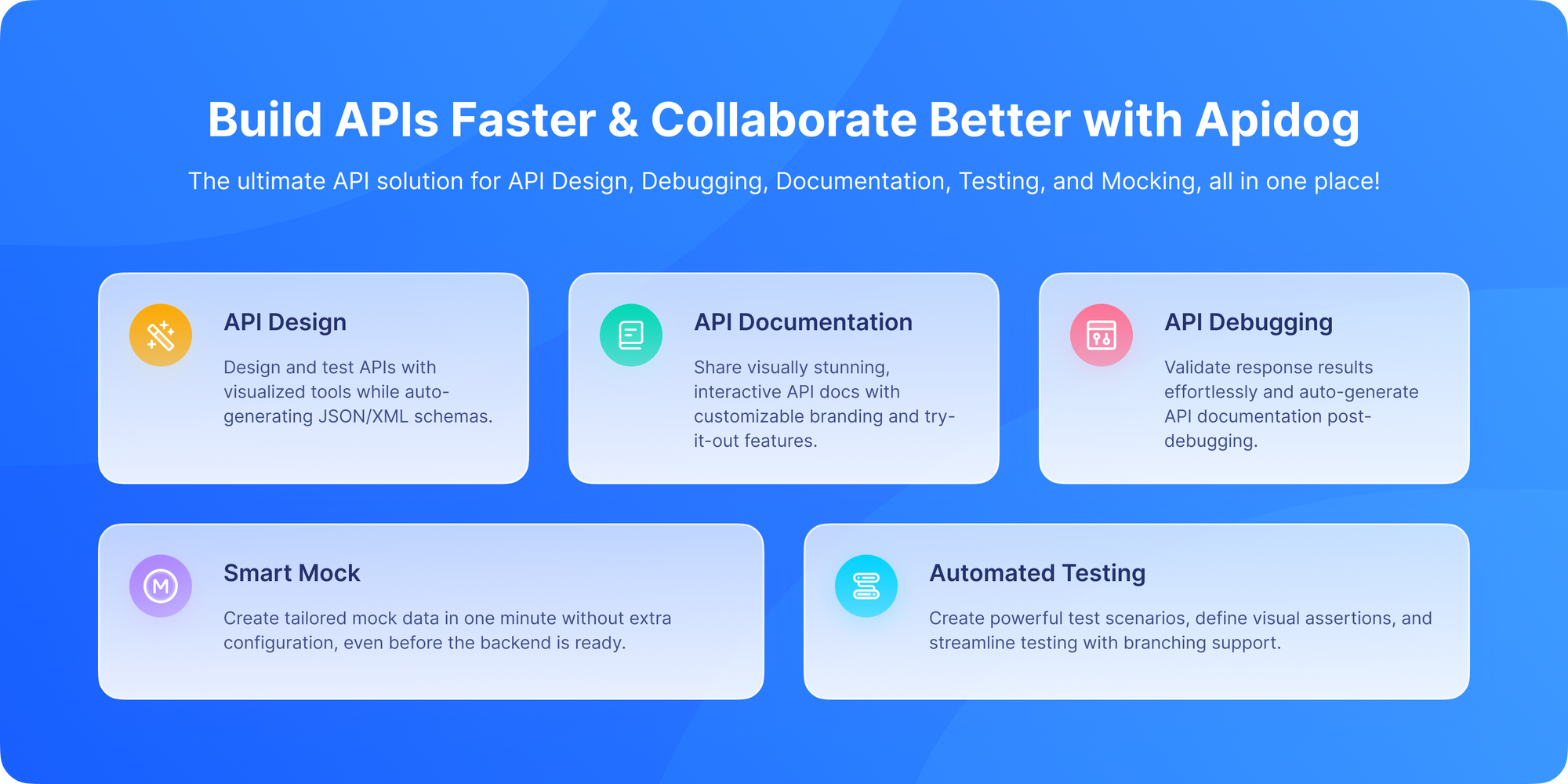
Developers today work with a variety of API protocols, creating a testing and management challenge. No matter which communication method you choose, you'll need to design, mock, test, debug and document APIs. That's where Apidog becomes essential.
Here's how Apidog helps:
- Design APIs visually (REST, GraphQL, gRPC, and more)
- Generate mock servers for testing communication methods
- Run automated tests to validate performance
- Collaborate with teams on API workflows
- Version control so changes don’t break existing integrations
Whether building a simple REST API, implementing complex event-driven WebSocket flows, testing a REST endpoint or simulating a WebSocket stream. Apidog provides the tools to test and manage your APIs efficiently and effectively.
How to Choose the Right API Communication Method
Choosing the best method depends on:
- Performance needs
- Data format
- Real-time requirements
- System architecture
- Industry regulations
The best protocol depends entirely on your use case:
- Building a public API? Start with REST.
- Need precise data fetching for a complex UI? Look at GraphQL.
- Building performance-critical internal microservices? gRPC is your friend.
- Need real-time, bidirectional chat? WebSocket is the answer.
- Sending data from a sensor? MQTT is the industry standard.
For instance, if you're building a real-time multiplayer game, WebSockets is your best bet. But if you're integrating with a banking system, SOAP might be the safer choice. Tools like Apidog are invaluable here. They allow you to prototype and test APIs across different paradigms (REST, GraphQL, WebSocket) in a single interface, helping you and your team evaluate the right fit based on real performance and developer experience, not just theory.
Conclusion: The Right Tool for the Job
API communication is the glue holding modern apps and systems together. From REST to gRPC, WebSockets to MQTT, each method has its place in the ecosystem. The landscape of API communication is rich and varied. While REST is a fantastic and versatile default, it's not the only tool in the shed. By understanding the strengths and weaknesses of these different protocols from the lightweight efficiency of gRPC to the real-time power of WebSocket you can make an informed architectural decision that sets your project up for success.
The key is to match the technology to the task. Don't force a WebSocket where a simple Webhook will do. Don't suffer with RESTful under-fetching when GraphQL is the perfect solution. Choose wisely, and build something amazing.
